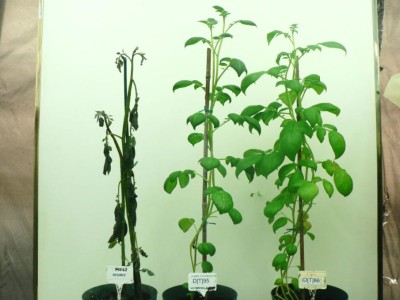Results from early trials conducted by CIP, show great promise in the global quest to tame late blight, the scourge of smallholder potato farmers and large producers globally.

CIP is dedicated to improving food security for smallholder farmers and reducing or eliminating late blight in potato would help CIP fulfill that mandate.
“Everywhere you grow potatoes, you have late blight,” says Marc Ghislain, program leader at CIP. “It is the number-one disease afflicting potato crops.”
Late blight, responsible for the 19th century Irish potato famine that led to one million deaths by starvation, still affects more than 3 million hectares of potato globally and causes economic losses estimated at 2.75 billion USD a year. In Uganda alone, loss due to late blight can be up to 60% which translates into annual loss of over 129 million USD.
Late blight’s other devastating effects include increased levels of poverty among populations dependent on potato for income and greater food insecurity.
Conventional potato breeding is slow and unpredictable, CIP program leader Greg Forbes notes, often taking decades to produce a new cultivar. By the time a gene is successfully introduced into a cultivated variety, the late blight pathogen may already have evolved the ability to overcome it.
Because of this, fungicides are the primary means farmers have to attempt to stave off against late blight’s advance, says Ghislain. Yet their application takes a significant bite out of smallholder’s profit margin that can be as much as much as one-quarter of a smallholder farmer’s annual profits.
Moreover, especially in developing countries, fungicides are often used incorrectly, reducing the efficacy of the product. Since farmers in these areas do not use protective clothing, there is an increased risk to human health, Ghislain warns.
“There would be a significant impact if we could provide to the smallholder a [potato] variety that is less dependent on fungicides” to thrive, he explains.
That’s a critical reason CIP is exploring a GM potato as one potential solution for late blight resistance. A race against the clock to stay in front of late blight and its potentially devastating effects on food security of smallholder farmers is of utmost importance.
“The GM approach is much faster than conventional breeding,” which can take decades, explains Forbes. “In theory, [late blight-resistant] genes could be incorporated into breeding materials with conventional breeding, but the time and cost are both much greater.”
CIP researchers have tested three genes from several wild potato relatives; preliminary results have shown them to be late blight-resistant. The results of this work “left us quite optimistic,” says Ghislain.
To test whether the resistance will hold in the field, trials began this year in Uganda and will go on for several seasons.
Late blight pressure is particularly high in Southwestern Uganda, explains Forbes and CIP has been working there with potato researchers in the hopes to find a potato that is resistant to late blight. The region “is representative of a large area where late blight is a major problem.” Moreover, Uganda has in place a regulatory framework for supporting GM crop research to combat the problem.
Isolation measures to restrict access to these research materials which are not authorized for commercialization have been taken. They range from restricting access to them by research staff only, separating test fields from other fields by a minimum of 100 meters and destroying all research material once the trial is completed.
“The goal of the field trials in Uganda is to confirm the greenhouse results of high levels of resistance in real-world conditions,” says Forbes. “It will be during the rainy season – and that will be much more like the [actual growing] conditions in farmers’ fields.”
Similar efforts that use different resistance genes from a number of potato species are underway by researchers in many countries, including Bangladesh, India, Indonesia, the UK, the Netherlands, Belgium and the US, Ghislain says.
Across these trials, positive results are leading researchers to believe that a combination of GM crops, breeding and reduced fungicide application, if any, promises to be the long-term solution to fighting late blight.
